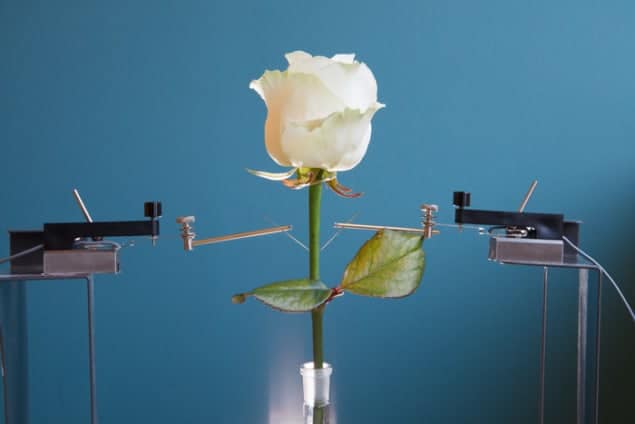
Researchers in Sweden have created electronic circuits and devices that are integrated within living plant material. The team introduced a conductive polymer into the vascular system of plants, which allowed the researchers to create the key components of an electrical circuit. They were also able to demonstrate transistor modulation, digital logic function and elements of a digital display. Plant-integrated electronics could enable us to monitor and regulate plant physiology and harvest energy from photosynthesis, the team says.
Organic electronic materials are polymers and molecules that can conduct and process both electronic and ionic signals. They can be shaped into almost any form and used to build devices that can convert electronic signals into chemical processes, and vice versa. The resulting electrochemical devices can then be used to regulate and monitor biological and chemical processes. Such technologies are currently being exploited in various medical settings, such as drug delivery, regenerative medicine, neuronal interconnects, and diagnostics.
Magnus Berggren and colleagues at Linköping University and the Swedish University of Agricultural Sciences are interested in whether similar organic bioelectronics can be used to sense, record and control chemical processes in plants. This could have many useful applications in agriculture, Berggren explains. For example, if you could monitor hormones that indicate when crops are ready to flower and were able to regulate that process, you could adjust flowering times to avoid periods of bad weather.
Conducting wires
The team tried merging electronic circuitry with sections of stems from Rosa floribunda (garden rose) by soaking them in solutions of conductive polymers. Only one, poly(3,4-ethylenedioxythiophene) or PEDOT, was taken up through the tube-like xylem, which transports water through the plant, and incorporated into the plant’s internal structure. The polymer was shown to have self-organized to form conducting wires – some of which were more than 5 cm in length – inside the xylem, while still allowing the transport of water and nutrients.
The researchers showed that the wires could interact with the electrolytic compartments in the surrounding cells. They used this interaction to create an electrochemical transistor that converts ionic signals to electronic output. They then created two such transistors in the same piece of PEDOT/rose-stem wire and showed that the pair can function as a NOR logic gate.
They also infused a variant of PEDOT into rose leaves, using a technique called vacuum infiltration. The conductive polymer made its way into compartments separated by the veins of the leaf, creating a 2D network of electrochemical cells. When a voltage was applied to the leaf, the polymer cells changed colour, indicating that they were interacting with the ions in the leaf.
Fundamental circuits
While the colour-changing leaves are a bit of a novelty, Berggren says they demonstrate that you can build “pretty advanced circuits inside the leaves”. He adds that although they have yet to develop sensors and other advanced devices, the research shows that you can create all of the “fundamental circuits and devices that are important to develop more dedicated applications for specific needs”.
This is yet another wonderful development in the field of living technologies Andy Adamatzky, University of the West of England
“This is yet another wonderful development in the field of living technologies – hybrids of wetware and hardware,” says Andy Adamatzky, director of the Unconventional Computing Centre at the University of the West of England. “I believe it could be used to develop embedded computers, where plants can sense their environments, analyse the information by employing internal computers and then send the results of their analyses to humans.”
The research is described in Science Advances.



